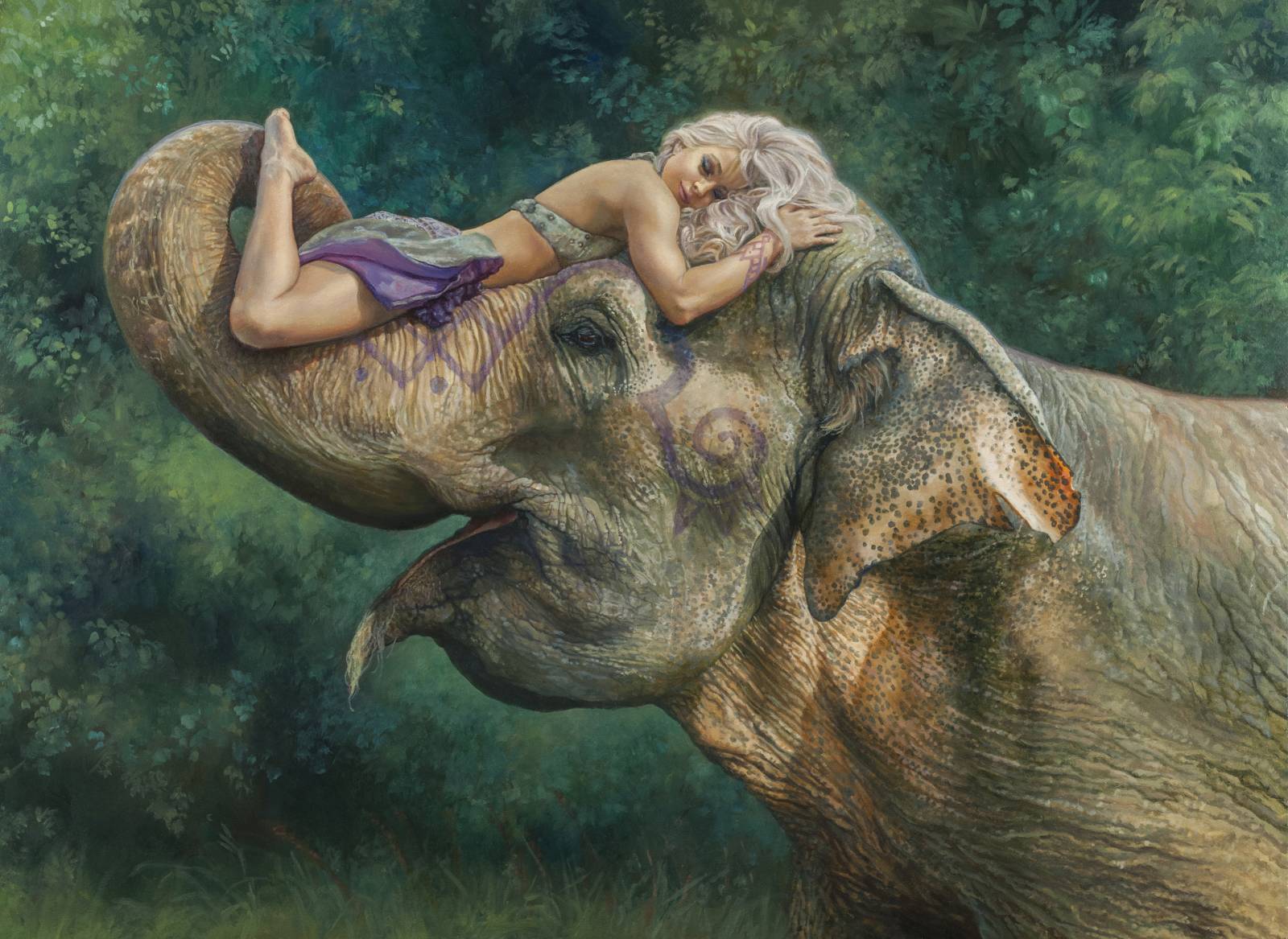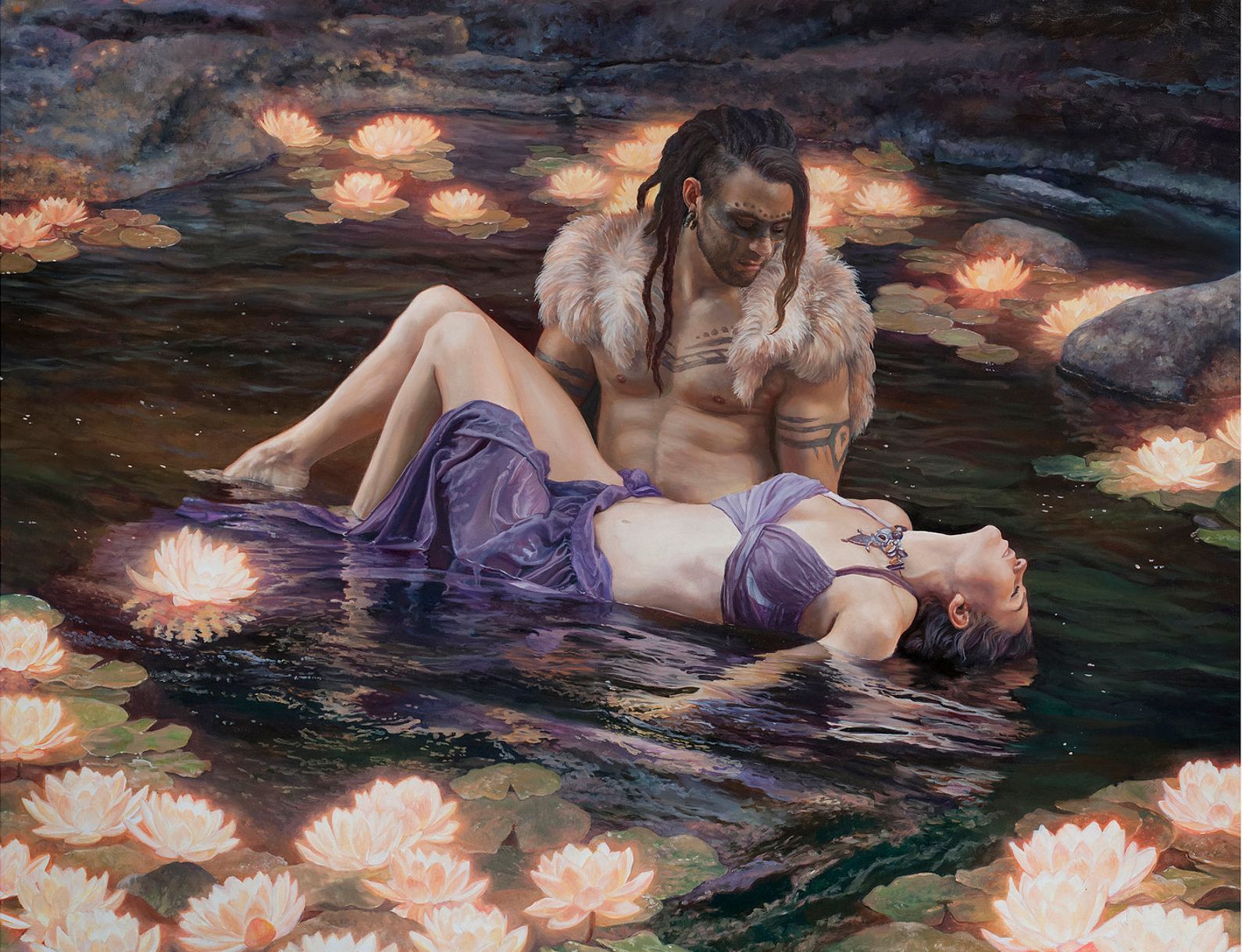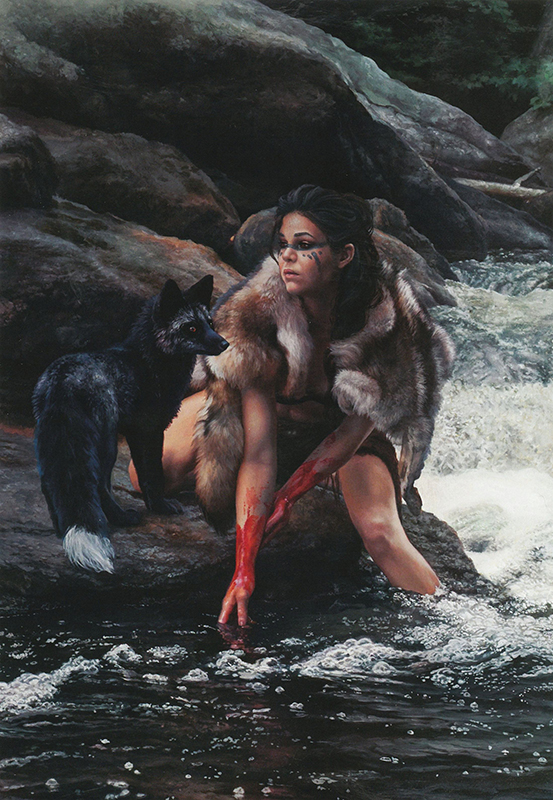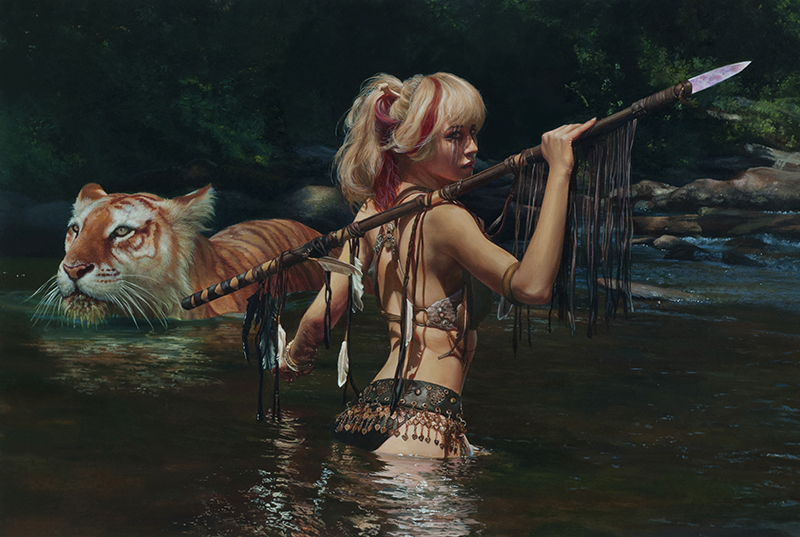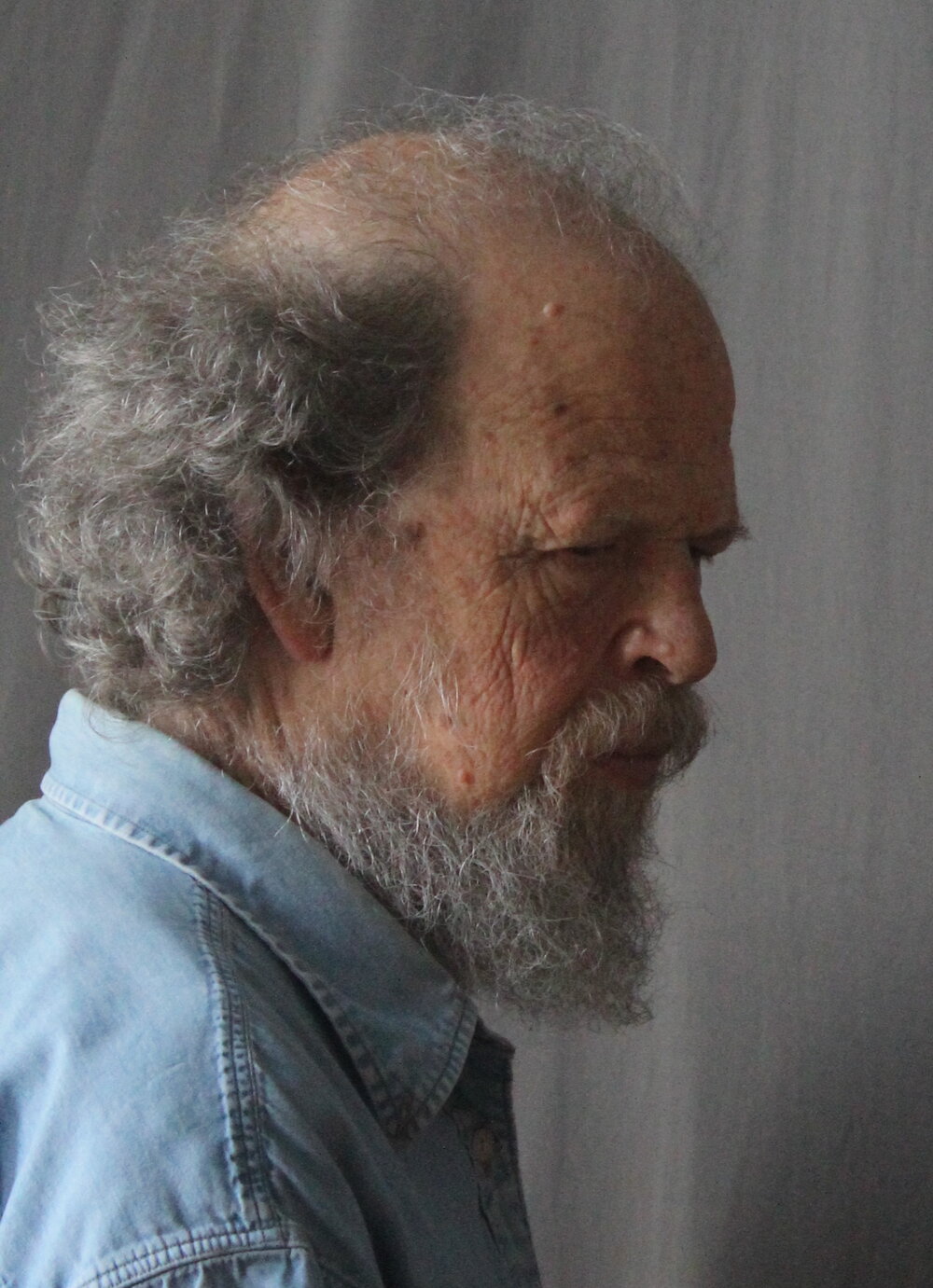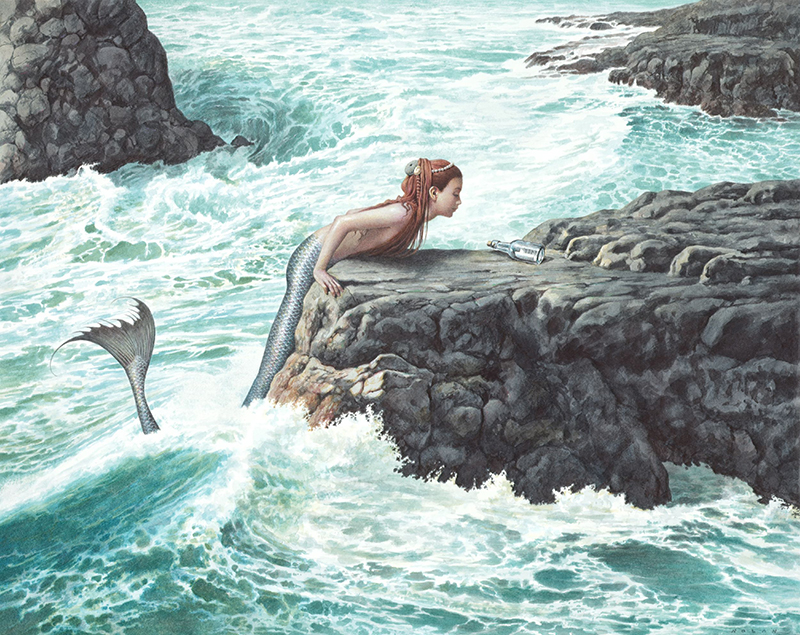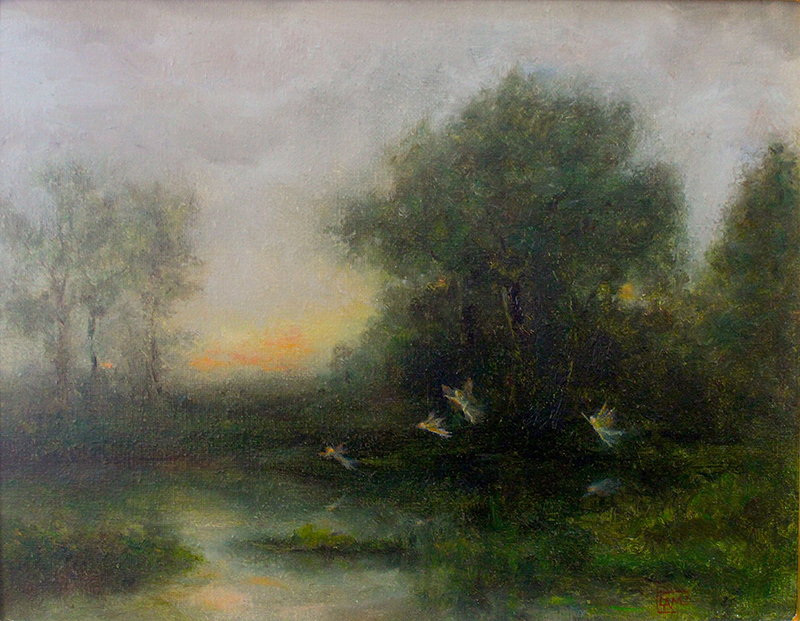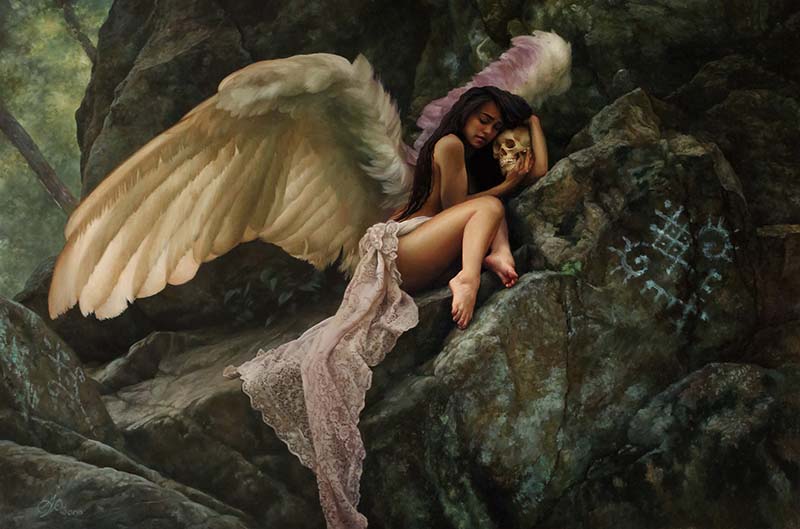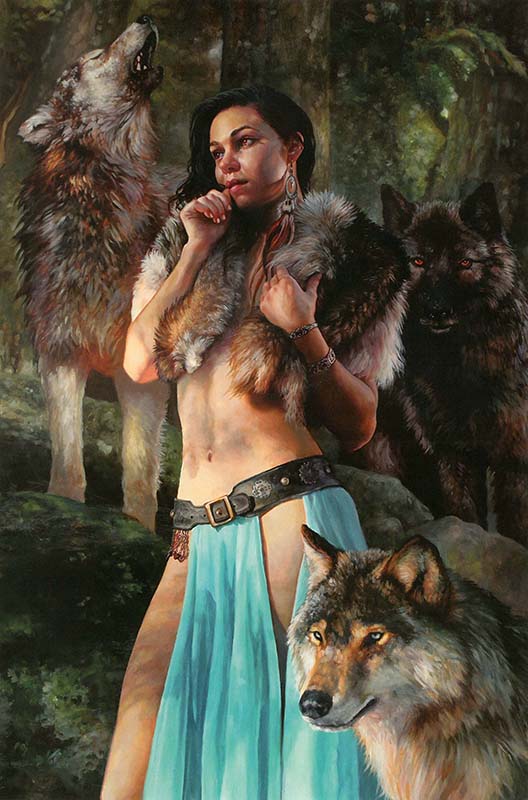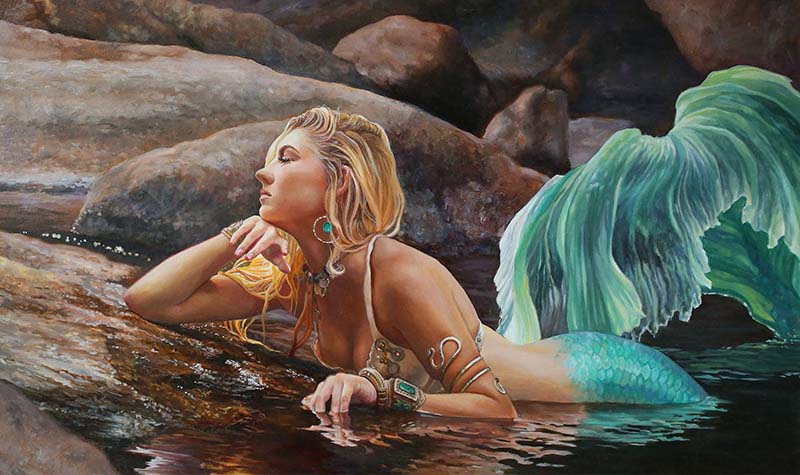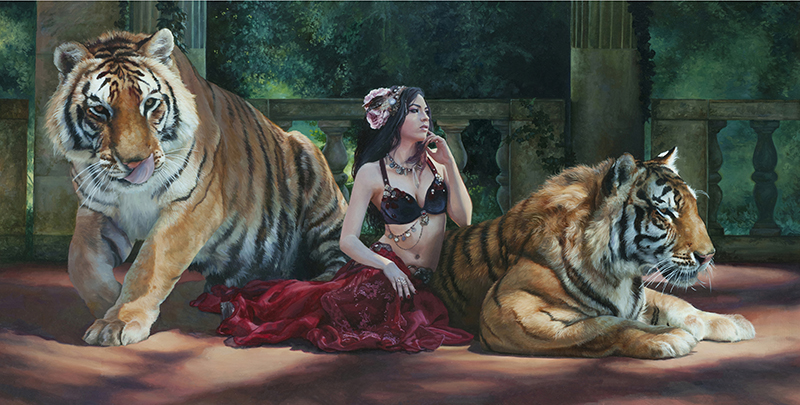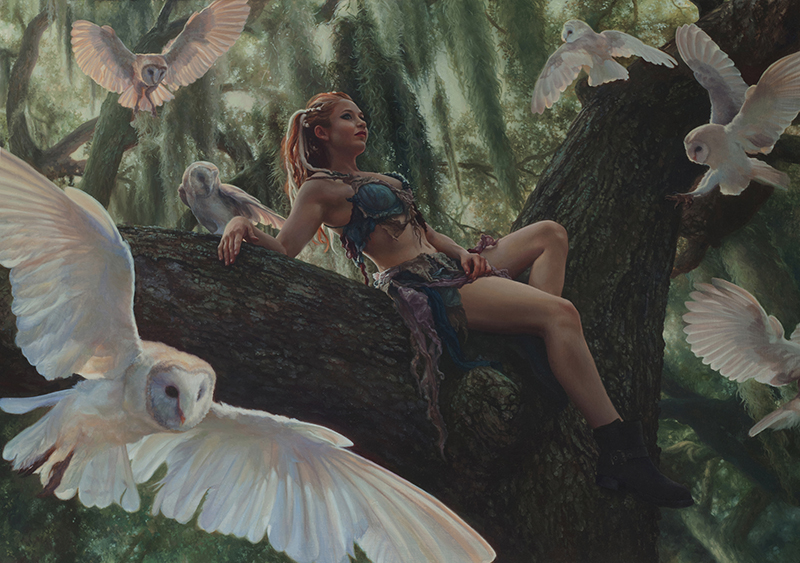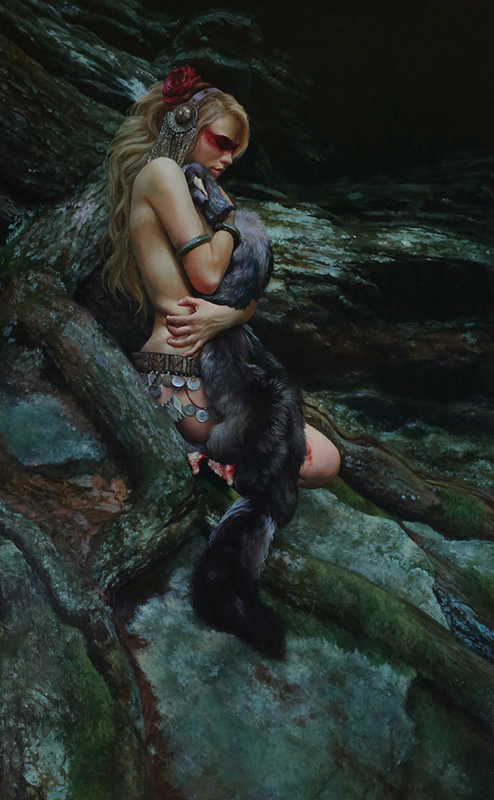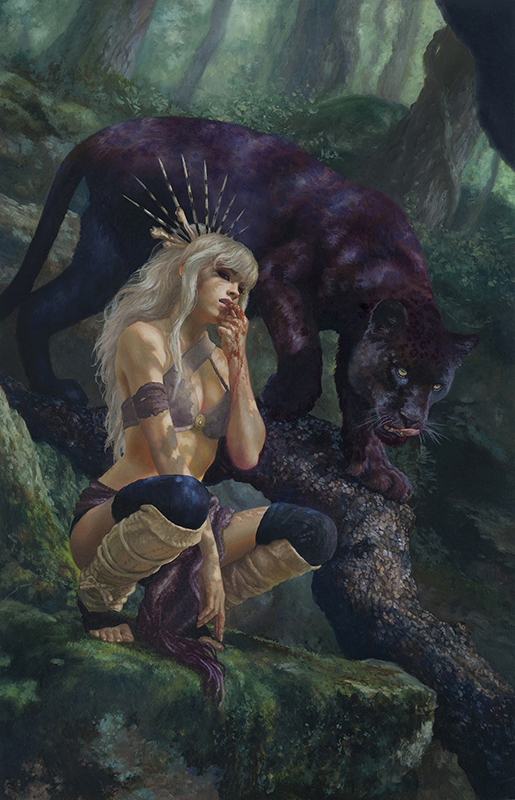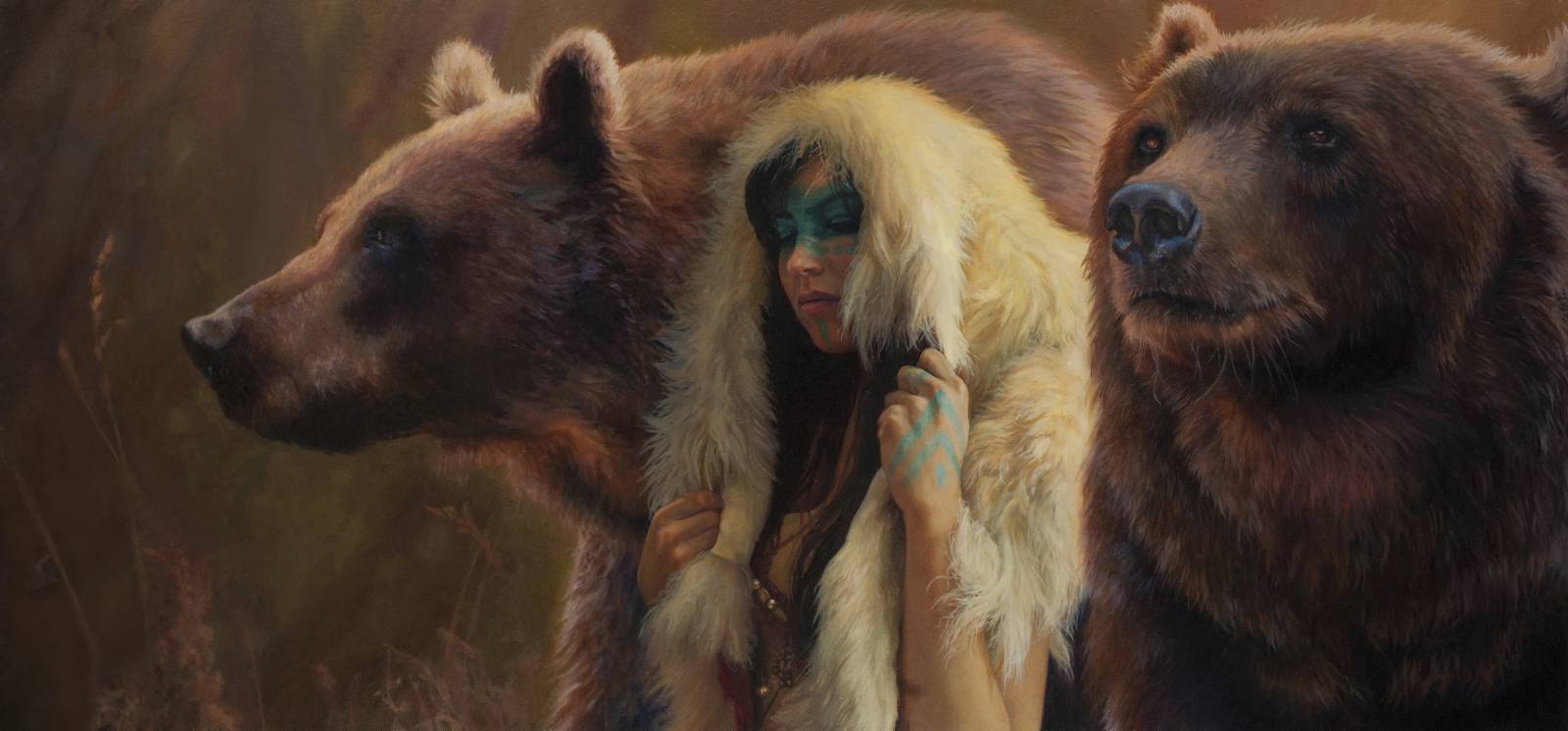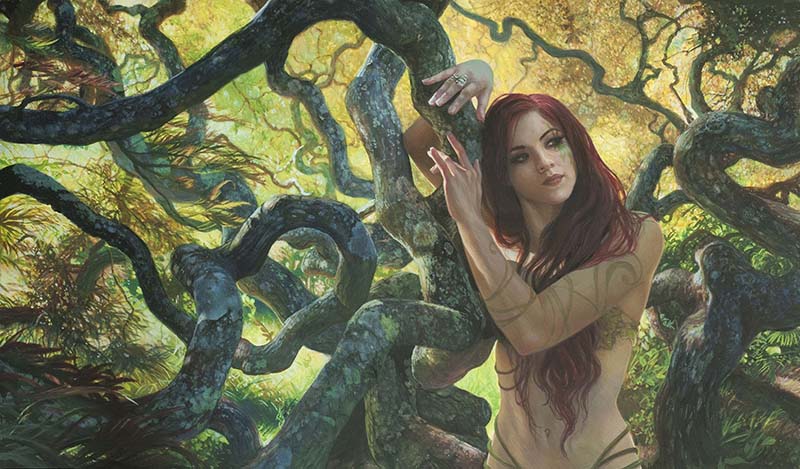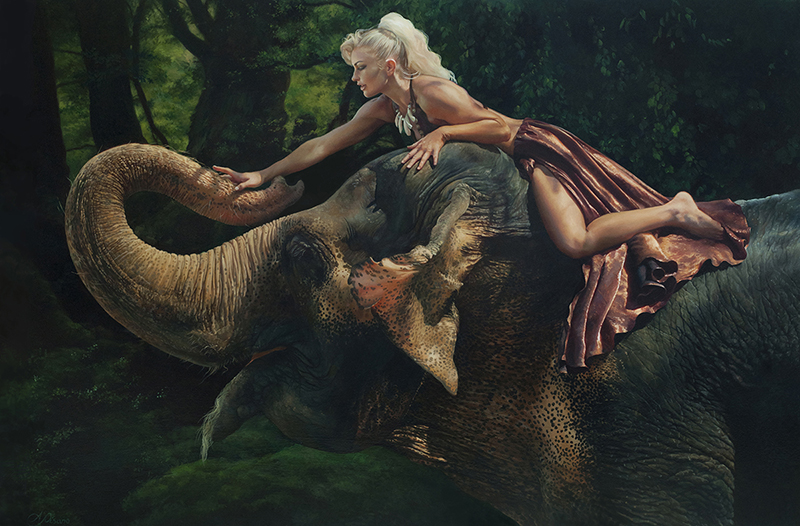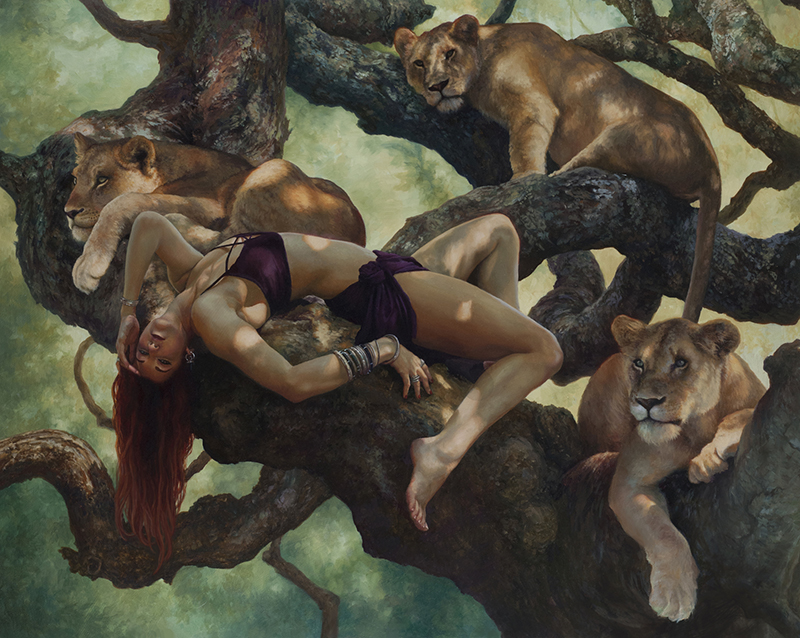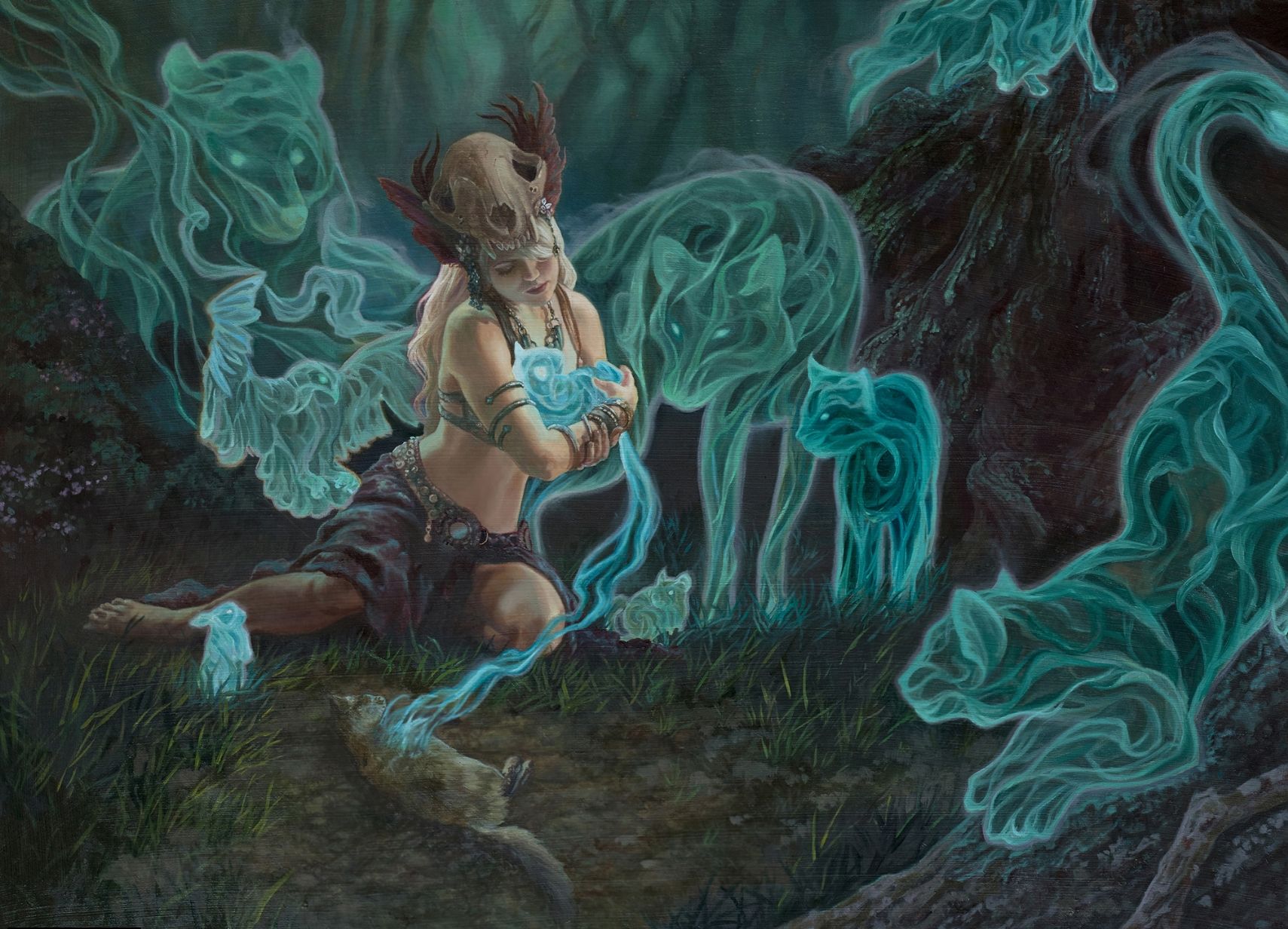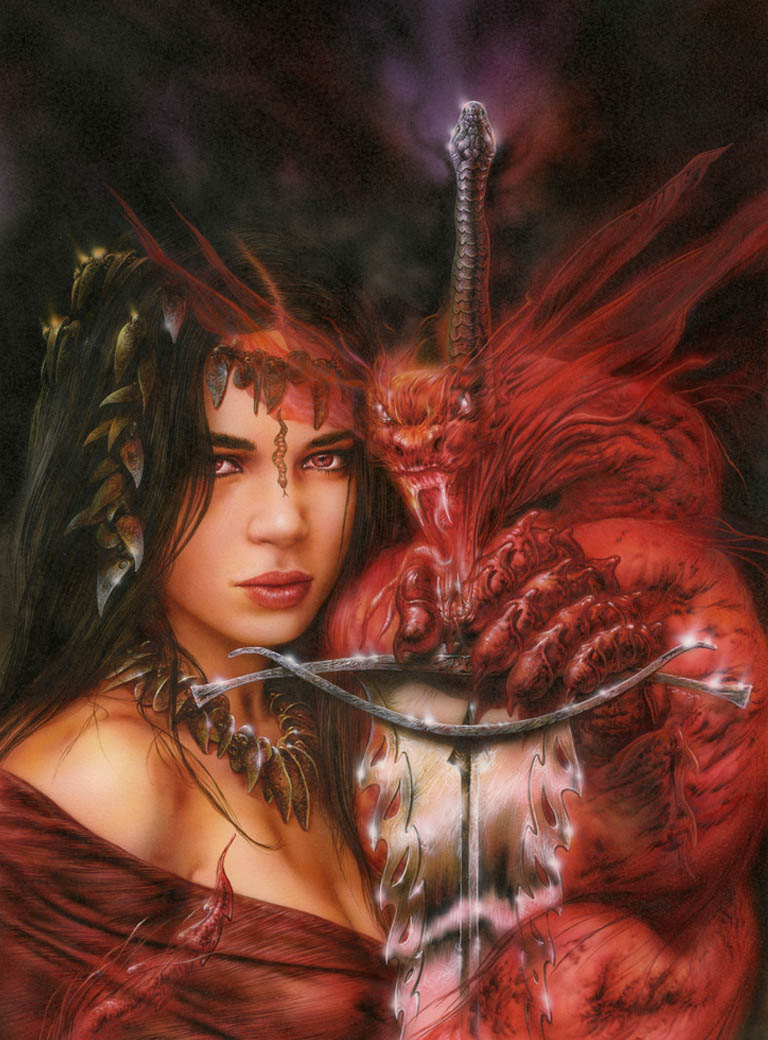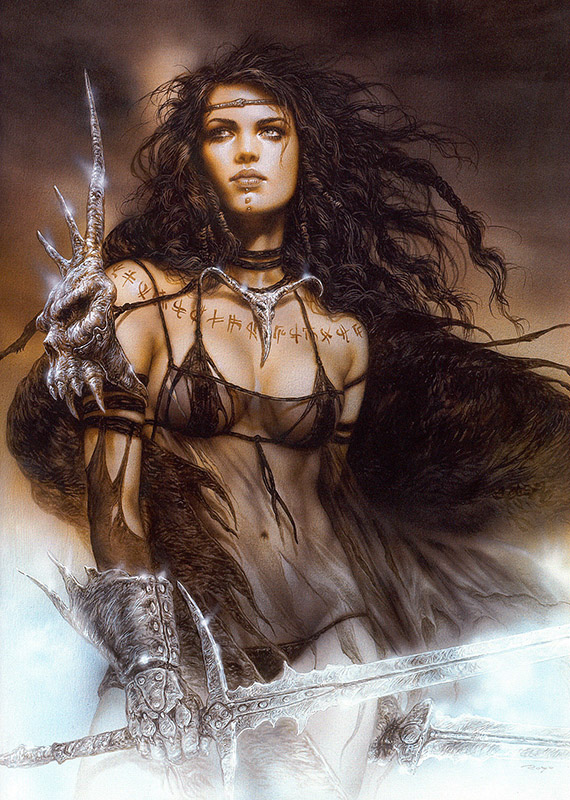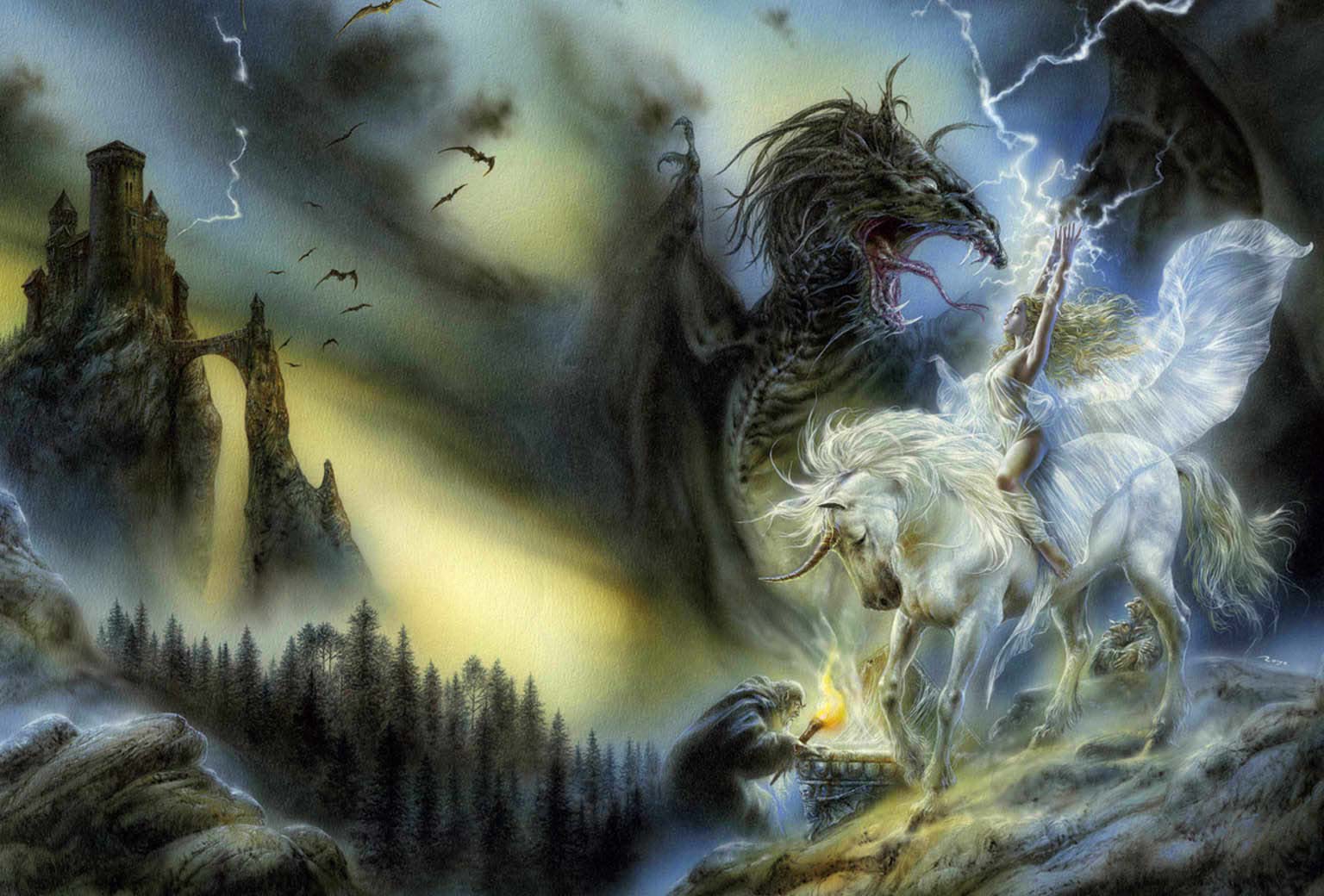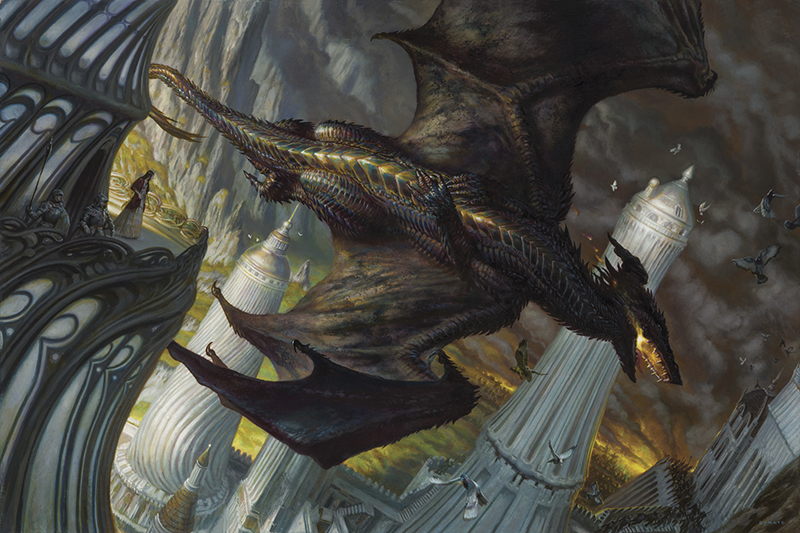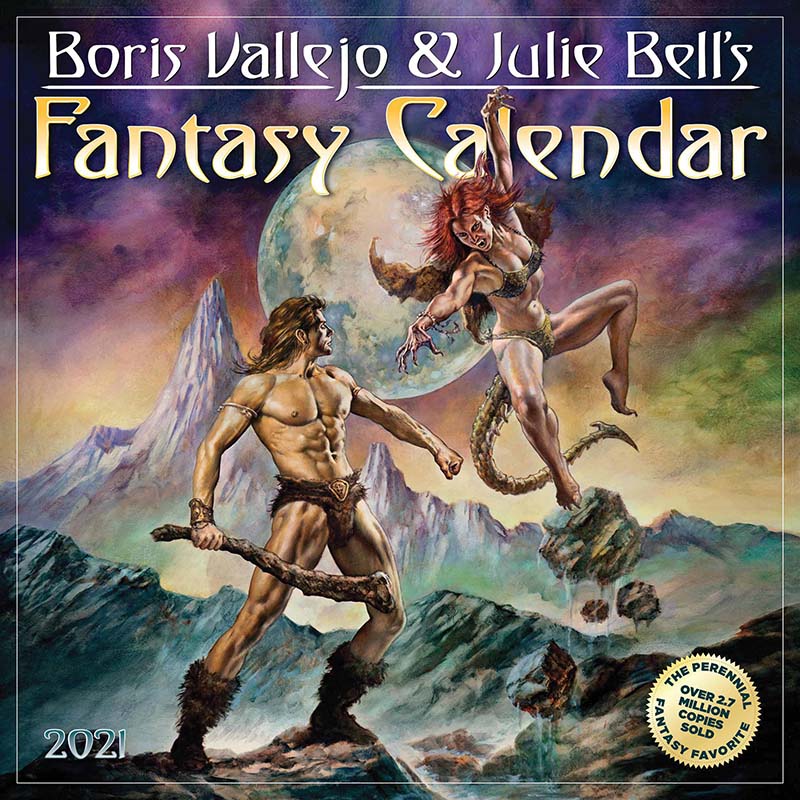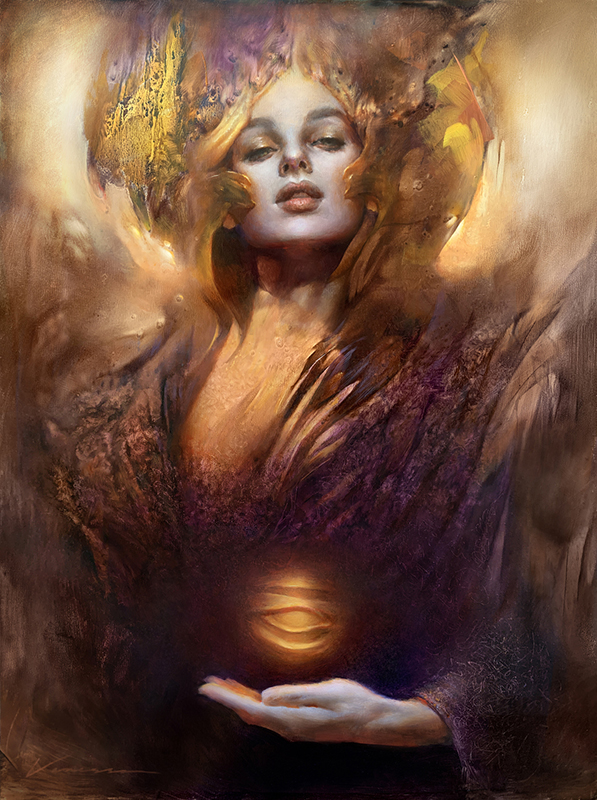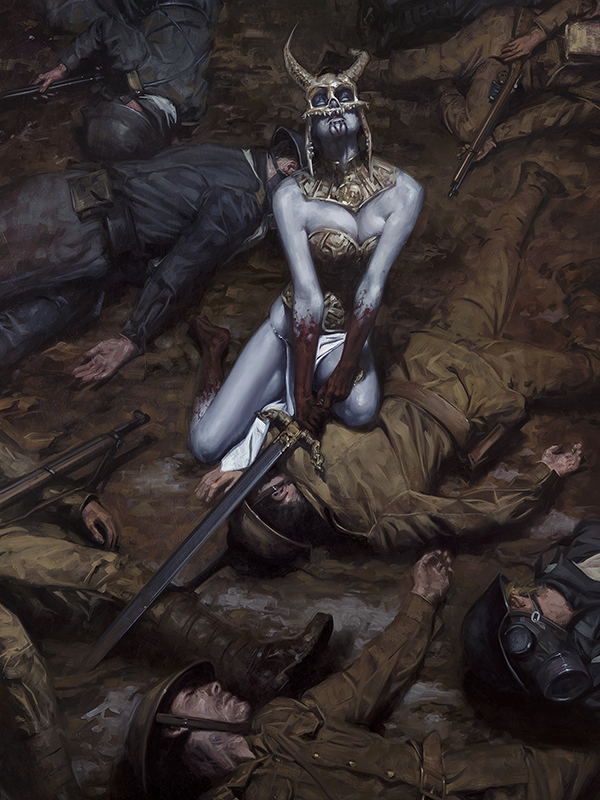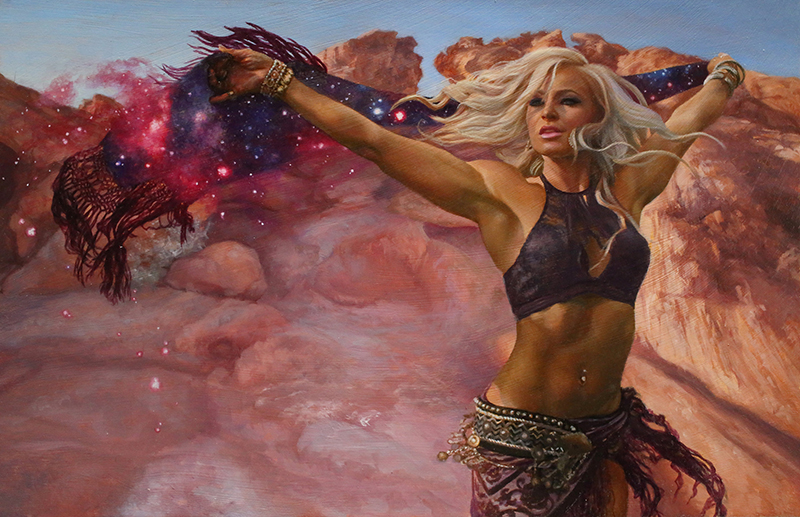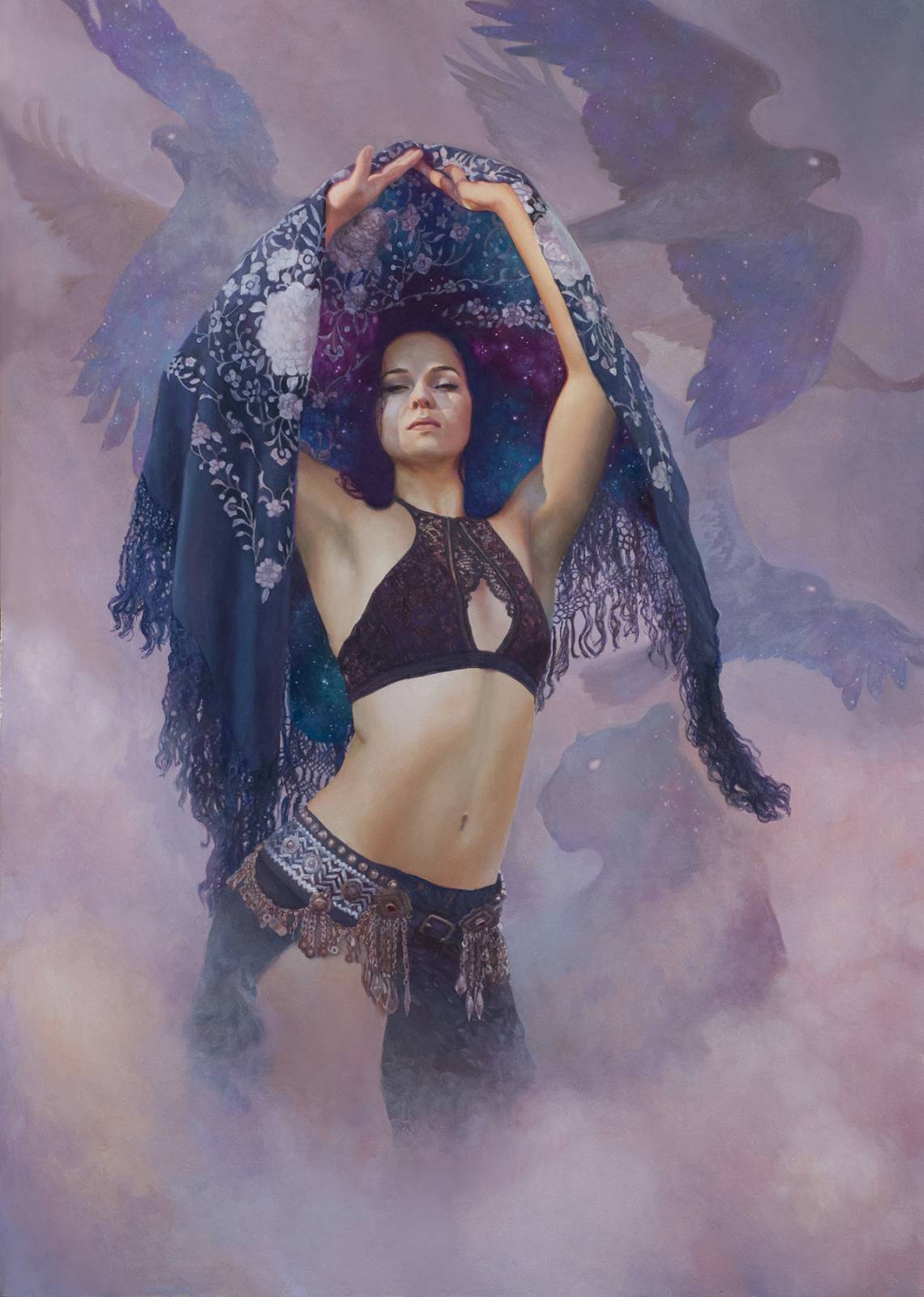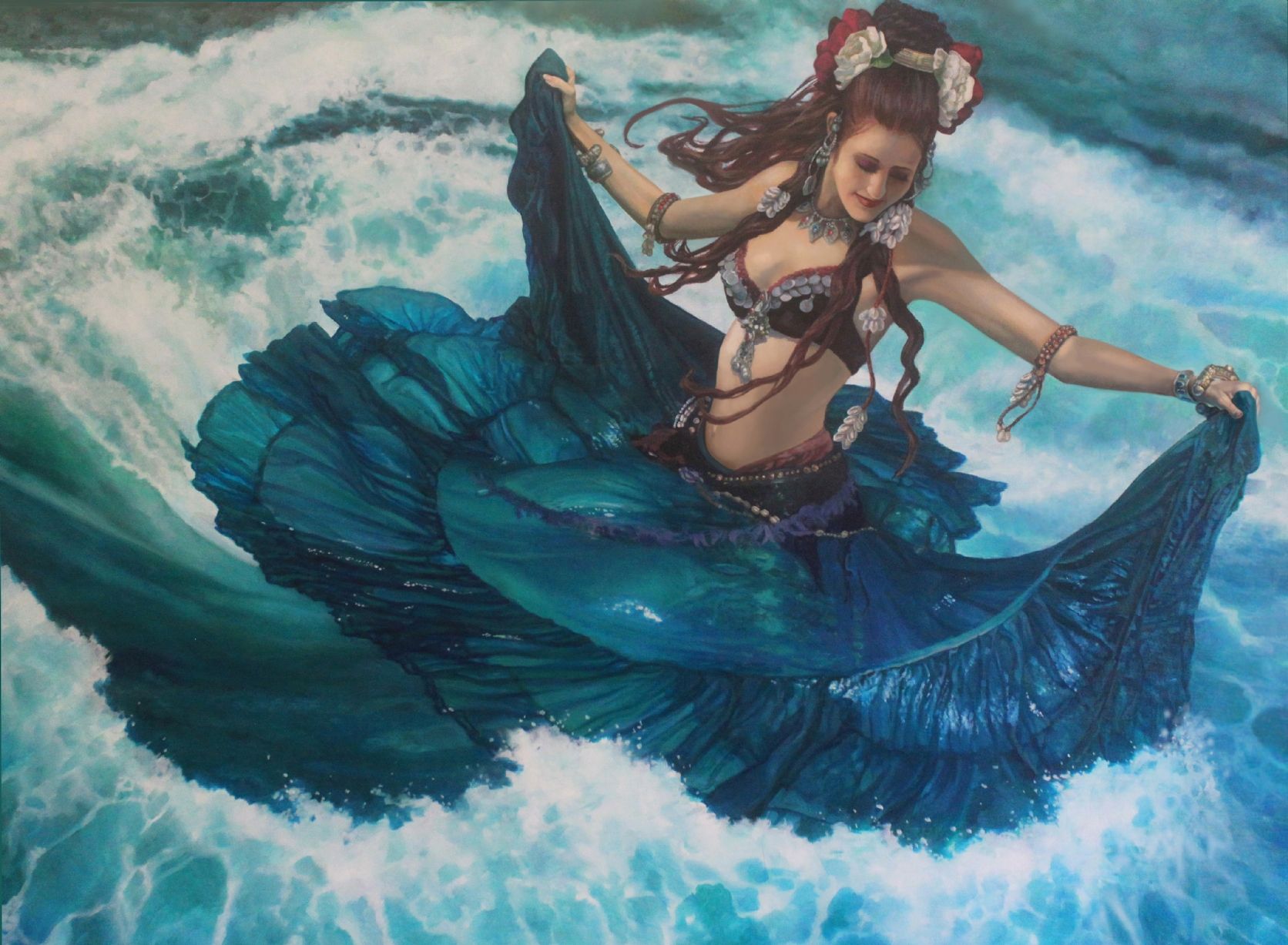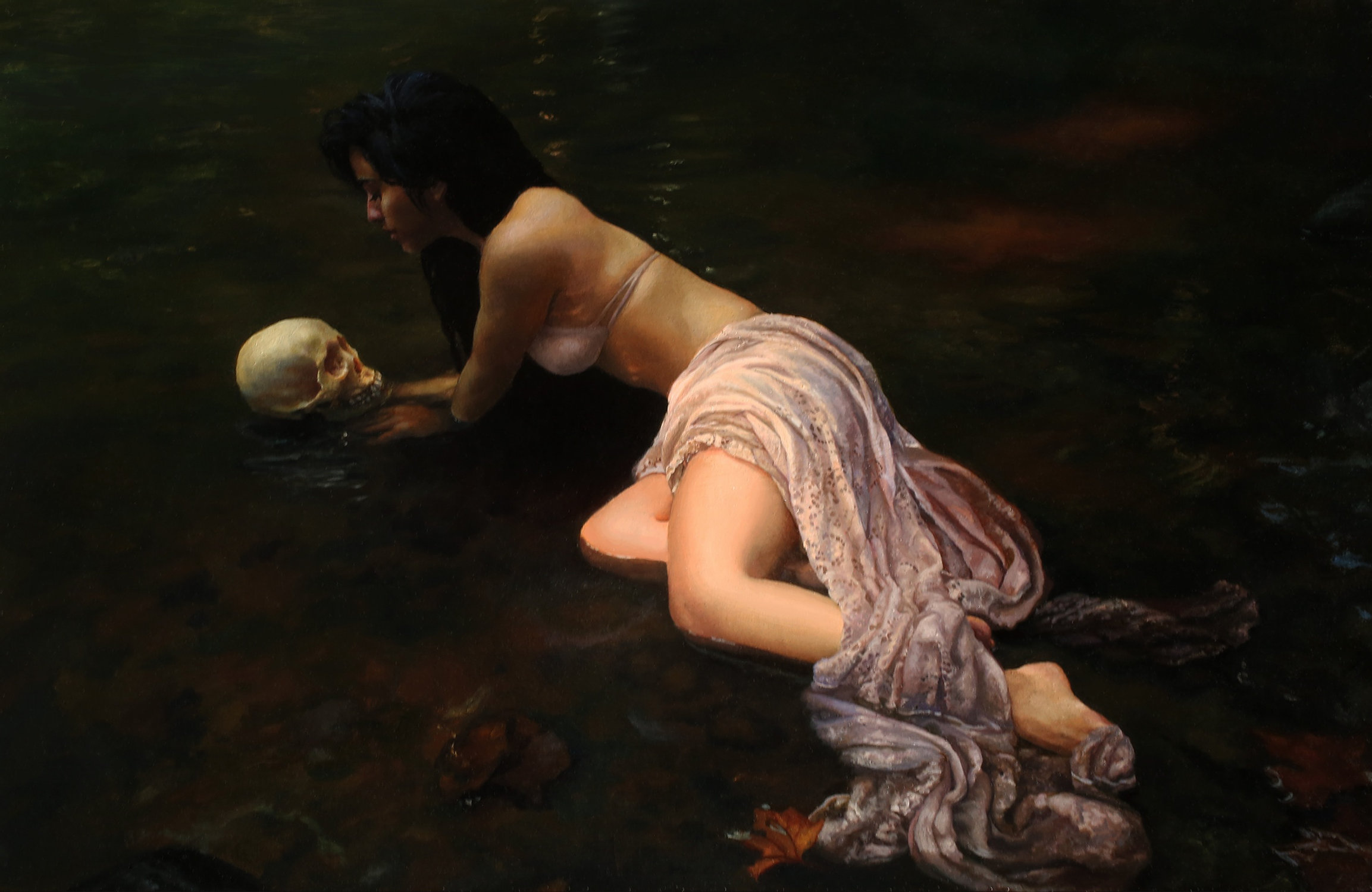Episode 07: Alessandra Pisano
Jesse Kowalski: Welcome to The Illustrator’s Studio. I am Jesse Kowalski, Curator of Exhibitions at the Norman Rockwell Museum in Stockbridge, Massachusetts. The Illustrator’s Studio is a weekly interview series, a project of the Museum’s Rockwell Center for American Visual Studies.
Alessandra Pisano is rapidly becoming a big name in the world of fantasy illustration. In 2016, she was given the Spectrum Rising Star Award. In addition, her work has appeared in the last four volumes of the annual Spectrum Fantasy Art Awards. She has created artwork for Sideshow Collectibles, Fantasy Flight Games, Upper Deck, and most recently Magic: The Gathering. She’s one of the youngest artists in this summer’s fantasy exhibition at the Rockwell Museum, Enchanted: A History of Fantasy Illustration, and she has a style distinctly her own.
Welcome, Alessandra. Thank you for joining us.
Alessandra Pisano: Thanks for having me.
Jesse Kowalski: We had noted that you began creating fantasy art at a very young age, as an escape and a refuge. I was wondering, what kinds of things inspired you growing up?
Alessandra Pisano: Well as a kid, I pretty much was just drawing, back to my earliest memories of being alive. I spent a lot of time, if I wasn’t doing that, in nature. Back then, you could just send your kids off into the woods and just be like, “Come back when it gets dark,” and that’s just how things were. I was either out playing in the woods, playing in rivers with salamanders, or I was just at home, drawing. I watched a lot of Disney movies back then, so typically I would copy Disney stuff. But, I was super drawn to The Lion King, so I just would draw those characters and make up my own situations for them. Those are the earliest drawing memories I have.
Jesse Kowalski: You graduated from the University of Hartford in 2011. Did you go to school for illustration?
Alessandra Pisano: Yeah. Yeah, that’s what my major was.
Jesse Kowalski: Did you study under Dennis Nolan, perhaps?
Alessandra Pisano: I did, yes.
Jesse Kowalski: Oh I just ask because a few artists in the exhibition studied under Dennis, who’s a good friend of the Museum.
Alessandra Pisano: Yeah.
Jesse Kowalski: What was it like working with him?
Alessandra Pisano: He’s a gem of a human being, so it’s good. He was one of the few who actually had, really, any experience in fantasy art, and that was always my goal. He was the go-to guy. I remember distinctly, I was working on a piece of an angel and she was holding a skull, but she was kneeling on the ground, and trying to figure out how the wings would work, when it came to them hitting the ground a certain way. Dennis was the guy to sit down and help me figure it out, because he just knew how to make up anything you wanted and had a brilliant mind about it.
Jesse Kowalski: That’s great. Yeah. So, in the exhibition we will have work by Dennis Nolan, and also his wife Lauren Mills, who’s also a great artist.
Alessandra Pisano: Yeah, wonderful. I’m a fan of both of theirs.
Jesse Kowalski: Terrific. What was the first artwork that you sold?
Alessandra Pisano: It was a commission by a math teacher, that I was failing her class, so that was kind of ironic, in high school. It was a color pencil piece, because for a long time I actually didn’t know how to paint so I always worked in Prismacolor pencils for the longest time. It was a piece of the outside of some villa in Paris that was for a friend’s wedding present. I think I got maybe $250 for that.
Jesse Kowalski: Did it help your grades?
Alessandra Pisano: I think she passed me by the skin of my teeth. Maybe it helped.
Jesse Kowalski: At what age did you start using oils?
Alessandra Pisano: I took one oil painting class when I was in college, because they make you try out everything, and I absolutely hated it. I didn’t actually come back to it until maybe a couple years after I graduated, and that happened because I had a desire to just paint something bigger than what I was doing. At that time, I was working in FW ink, so there’s a limit to how big you can work with them. I made the switch to oil. I think my first oil painting actually came out pretty decent, and then it got pretty not so great. And then, just spent a lot of time making a lot of mediocre paintings until they slowly got better and better.
Jesse Kowalski: When I’m creating an exhibition, my intention is always to entertain and educate. I view museums as a refuge for people to get away from the real world. I noticed a similar thought on your website. You write, “My goal is to give you something beautiful and distracting to get lost in, even just for a moment.” I wondered, when you’re creating an artwork, what do you find are important factors in helping someone get lost in a painting?
Alessandra Pisano: Well, I usually don’t think about that. When I paint, it’s always very self-serving and entirely just whatever I’m feeling into at the moment. But, I think there are certain elements for sure, that can help people get more captivated by something over another thing, and that’s all a deeply personal and individual thing. But ultimately, I think the piece has to have a human quality to it. Even if there’s nothing human about it, there’s got to be something relatable. And again, that’s so individual.
Jesse Kowalski: Who do you make the paintings for? For yourself, or do you have other people in mind?
Alessandra Pisano: No. Again, it’s entirely very selfish. It’s entirely just whatever I feel like doing. Usually for me, it’s always important to include my friends, and my friends are generally the models. But, I think that’s because one, I have that luxury currently. I’m sure as my career continues in life and if I jump around, that might change and what not. But for right now, I have the luxury to include people that are important to me. When I’m going to be spending 40 to 60 hours on a piece, I want to be staring at somebody that I admire very greatly.
Jesse Kowalski: Do you take commissions?
Alessandra Pisano: I do. I usually only will take on maybe one or two a year, and I’m a little picky about it. It’s got to be something that I’d want to paint.
Jesse Kowalski: Do you work with the person, or do they generally leave it up to you to decide the subject?
Alessandra Pisano: Usually, someone will come to me and have an idea. If I’m into that idea, then for sure. And then, we’ll do some sketches and see which one they like, but mostly I just do my own thing on it. Sometimes I’ll get people who are just like, “How about you just paint whatever you want to paint and we’ll take it,” kind of thing. Those are good, too.
Jesse Kowalski: At the Spectrum 27 Awards, you received a nomination for a gorgeous painting called The Part You Throw Away. I was wondering what the inspiration was for that piece?
Alessandra Pisano: That was a personal piece that had to do with a spiritual healing journey I’ve been on the last few years and had to do with… There’s an old Cherokee tale that’s about a white wolf and a black wolf that live inside all of us, and the one that you feed the most is the one that’s going to take over your personality and your reactions. It’s mostly about getting rid of the parts of yourself that no longer serve you anymore, but honoring how far they got you to where you needed to be, at the same time as you are shedding them for something more serving.
Jesse Kowalski: What was the moment when you first realized that you might have a successful career in illustration?
Alessandra Pisano: I don’t think I did.
Jesse Kowalski: You’re still waiting?
Alessandra Pisano: I mean, this is just a thing that I’ve been doing for as long as I can remember that I’ve been doing it, and I don’t think there was ever… Obviously, in the last several years my income… it’s been better than it was before, but I don’t think the thought of success ever has crossed my mind. It’s just… I’m just going to keep doing this, because it’s all I know how to do at this point and in too deep, and hopefully it hits and resonates with people. It seems to be doing all right.
Jesse Kowalski: When I see one of your paintings, I’m struck with the similarities to some Golden Age illustrators, especially to the Western art of N.C. Wyeth. You know, the solitary cowboy in the American West, surviving on his own in the wilderness. That seems to be a recurring theme in your work, but with female subjects instead. Can you describe the central motif running through your work?
Alessandra Pisano: I think I mostly just keep coming back to nature. I think I can only really think that that’s the case because nature is very sacred, and it’s very much a part of all of us and something we forget how attached and embedded we are to it. It just keeps popping up for me, so I’m just going with it. To be honest, I’m figuring out my own work as much as anyone else is.
Fun neuroscience fact. We’re actually 95% unconscious to any of the decisions and choices we make in life.
Jesse Kowalski: Your paintings typically have some type of wild beast in them, some kind of protector or a companion. Is there a deeper meaning in there?
Alessandra Pisano: I’ve just always really loved animals, since I was very young. I’m always exploring that connection, that animal-human bond that happens. Animals have a purity to them, and an honesty that people don’t always have. They also have very deep souls, and I just like trying to capture that and put it in my pieces.
Jesse Kowalski: Sometimes, better than people.
Alessandra Pisano: Yeah, most of the time.
Jesse Kowalski: Who are some of your major artistic influences?
Alessandra Pisano: Luis Royo actually was the first fantasy artist that I ever discovered, when I was a teenager. His book was on an end cap in Barnes & Noble and I was just completely mesmerized, and blown away by it. And, didn’t realize someone could paint like that. He’s always been a nostalgic hero for me.
But then, later on when I was introduced to guys like Donato. Someone had given me one of Boris & Julie’s calendars, and of course them… that’s very much influenced my work for sure.
Jesse Kowalski: Yeah. Among the living artists that you admire besides Donato, Boris, and Julie, are there others?
Alessandra Pisano: Oh yeah. Vanessa Lemen, Dave Palumbo, Rob Rey. I especially love art the most that’s different than what I do. They have such thick and beautiful brush textures, I don’t paint like that. But man, I love when other people do. I wish I knew how to paint like that. I really enjoy seeing their work. I think Vanessa’s pulling stuff from a completely different plane. She’s really grabbing something in the ethos that I think is really powerful and magical in a lot of ways.
Jesse Kowalski: Your work is so unlike other fantasy artists, especially in the exhibition, it was such a challenge to categorize your work, to fit it in with the other artists. I was just wondering, what do you consider the genre of your work, within the fantasy genre?
Alessandra Pisano: Oh. I don’t know. I don’t know how I’d categorize it. Again, it’s all so personal and self-serving for me, so how somebody else wants to categorize it, I don’t know.
Jesse Kowalski: Do you use photographs, live models, or props when you’re creating your work?
Alessandra Pisano: Yeah. Like I said, I tend to work with my friends. We won’t always have all the props or costuming, but I try to get it as close as possible. I feel like if I can get it as close as I can, I have an easier time making up the things that aren’t there. Generally, I’ll do that. But you know, there’s usually never that one perfect shot, it’s a Frankenstein effect that tends to happen. Which I know Dan DeSantos has talked a lot about that with his reference photos, where he might take, “Oh, there’s a really good hand there but her face looks good here, so let’s combine them and make something with this.”
Jesse Kowalski: I know that you’re into dance, so I was just wondering what your background is in dance? And, especially it seems like belly dancing is influenced in your work?
Alessandra Pisano: Yeah. When I was little, I did some ballet, I did a little ballroom dancing, and then I took a break from all that. I got back into dance in the form of belly dance in my senior year of college, so it’s been about ten years now. And really, the movements and the costuming heavily inspired me, and definitely inspires my work a lot, too.
Jesse Kowalski: Yeah….
Alessandra Pisano: …And also, how I will pose my models, I mostly work with other dancers and performers because they really know how to capture movement or a feeling.
Jesse Kowalski: What’s your daily work schedule like?
Alessandra Pisano: That is a constant struggle balance. But usually, I’ll get up in the morning, have my coffee, do some yoga. And then, I’ll get settled in around 9:30, 10 o’clock in the morning, and then I’ll try to paint until about six. If I have a deadline, maybe a little bit more. If I got a bunch of work done, I’ll try to stop less. But I’m really trying to figure out a balance where I’m working a little less, and living a little more.
Jesse Kowalski: How long does it take you to typically complete a painting?
Alessandra Pisano: I think it depends on the piece. If it’s something tiny, maybe a couple days. An average piece takes maybe about six days. And then, something that’s on a larger scale that’s more involved could take anywhere between two and a half weeks to maybe even a month to do.
Jesse Kowalski: Do you prefer work-for-hire or personal projects? Because it seems like a lot of your work is done as a personal piece, but you just scored this great gig with Magic: The Gathering, right? It must pay more anyway, right?
Alessandra Pisano: I definitely prefer the personal stuff. But with Magic, that was a special thing for me since I’ve been a big fan of the game since I was fifteen. That’s probably my one exception, where I actually stopped trying to look for company work for several years and just focused on my own thing because I found that that’s where I was finding the most joy. And, it’s when I did that, that Magic came around with this opportunity. That’s probably my one exception to painting things that I wouldn’t normally paint, just because of how much I love it.
Jesse Kowalski: When I did my interview with Donato, we were talking about growing up, and I grew up in Kansas. It was in the ’80s, so I wasn’t allowed to play Dungeons & Dragons and things like that, because it was called the “Satanic Panic.” Everyone was terrified.
Alessandra Pisano: Yeah, you don’t want to worship the Devil with your D&D.
Jesse Kowalski: Yes. Did you ever encounter that with Magic?
Alessandra Pisano: No, because I grew up in Connecticut. And by the time I even discovered Magic, I was fifteen and my boyfriend at the time played it. I saw the second variation of the Serra Angel card and was just completely blown away. I’m like, “Wow, people can paint this and there is a job for it? This thing that I’ve been doing, my whole very short life, there’s work out there?” No, I didn’t have that same issue as someone from the Midwest might have.
Jesse Kowalski: What’s the thing that makes your work most worthwhile?
Alessandra Pisano: It’s very satisfying for me to do, so I think that’s the biggest thing is really enjoying what you love to do.
Jesse Kowalski: How are you doing during the pandemic? Are you getting commissions, or do you have a personal project you’ve been working on?
Alessandra Pisano: Ironically enough, I got hired for Magic on Valentine’s Day of last year, so right before the pandemic started. Throughout the pandemic, I’ve just been painting Magic cards, and then in between that, my personal work, so really nothing changed for me working.
Jesse Kowalski: What draws you to oil painting over other media?
Alessandra Pisano: To be honest, I’m surprised I like oil painting myself because like I said, I absolutely hated it when I took that one class in school and now, here we are. Just all oil painting, all the time. But, I like how quick it can be, I like how big or small it can work, it doesn’t matter. I do like how the finished piece looks, with all the varnish and the shininess.
I would say my first love is still egg tempera painting, but I haven’t found time in the last few years to do one of those. But man, those are very satisfying to do even though they take so long.
Jesse Kowalski: Do you do any work digitally? I guess, what role do you think digital art will play in the future of fantasy illustration?
Alessandra Pisano: I do not do digital art, and I am very bad at digital art. For me, it’s not going to play much of a role. But, I think hopefully there’s still always going to be traditional painters out there. I think for convenience, sometimes digital art might become more popular. But, I don’t think either form will ever really go away.
Jesse Kowalski: Where do you see yourself in, say, twenty or forty years?
Alessandra Pisano: Honestly, I feel like in twenty years I might want to be retired with painting. I think my life plan, which it’s silly to ever make plans for anything or anyone, would be to just stack up a bunch of money, buy some land, get a house set up on said land and just keep living costs low, and just enjoy life. Because at some point, when we’re all laying on our death beds, I don’t think any artist you talk to is going to be like, “Man, I really wish I did that one more piece.” That’s not what any of us are going to say.
I hope in twenty years to be doing whatever I feel like doing in twenty years’ time. Maybe I’ll still be painting a little bit on the side, but I guess we’ll see.
Jesse Kowalski: All right, we’ll check back then.
Alessandra Pisano: Yeah.
Jesse Kowalski: What do you consider to be the difference between illustration and fine art? Do you consider yourself a fine artist or an illustrator? There’s only one right answer here.
Alessandra Pisano: I mean, I think I’ll always consider myself an illustrator, even though technically how I do it is fine art, so both.
Jesse Kowalski: What projects are you working on now?
Alessandra Pisano: Magic cards. I got two Magic cards I’m doing right now. I just finished one yesterday, so now I’m getting the other one done. And then, also trying to figure out where I’m going to throw in some more personal pieces, after this card gets done.
Jesse Kowalski: What is the thing that you’re most proud of?
Alessandra Pisano: I am proud of where I am today. I appreciate the evolution I’ve been on to get to this point, I appreciate the struggles I’ve had. I appreciate the failures I’ve had because everything has led to the point now where everything is slowly coming together, falling into place.
Jesse Kowalski: That’s great. As a young artist who has achieved so much success at an early age, I guess what insights can you provide to artists who are struggling?
Alessandra Pisano: Take risks. You have to be very comfortable with making mediocre art for a long time, because that’s how you get good. There’s no quick way to get here, you’ve got to put in your 10,000 hours with anything. But when you get there, man, it’s incredibly rewarding. Take those risks, and just keep going. Don’t take the failures too personally. There’s gifts to everything, there’s gifts to the darkest moments you’ll have and there’s gifts to the lightest moments you’ll have. Just keep going, and if you had a shitty childhood, that’s only going to help you.
Jesse Kowalski: Excellent. That’s all the time we have for now. Thank you so much, Alessandra, for agreeing to be in the exhibition, and also for joining us today.
Alessandra Pisano: Of course, it’s a huge honor. Thank you.
Jesse Kowalski: For more information, check out Alessandra Pisano’s website at A-L-E-S-S-P-I-S-A-N-O.com, and our own websites nrm.org, illustrationhistory.org. And, visit the Rockwell Center for American Visual Studies at rockwell-center.org. As always, don’t forget to subscribe to be notified for the latest content. This has been a production of The Norman Rockwell Museum.
To watch the video of this podcast or to see the images referenced in this episode, please visit nrm.org/podcast. New episodes from The Illustrator’s Studio are released every Monday. For questions or comments, please email us at podcast@nrm.org.
VIDEO
IMAGE GALLERY
1. Alessandra Pisano, Kindred Spirits, 2017
2. Alessandra Pisano, Revival, 2016
3. Alessandra Pisano, Revelations, 2017
4. Alessandra Pisano, Scavengers, 2019
5. Dennis Nolan, Self-Portrait, n.d.
6. Dennis Nolan, Message in a Bottle, 2009
7. Lauren A. Mills, Dawn Faeries, 2018
8. Alessandra Pisano, Memento Amare, 2020
9. Alessandra Pisano, Freya’s Dance, 2016
10. Alessandra Pisano, Daydream, 2018
11. Alessandra Pisano, Guardians, 2018
12. Alessandra Pisano, Whispers on the Wind, 2019
13. Alessandra Pisano, The Part You Throw Away, 2019
14. Alessandra Pisano, Blood Lust, 2017
15. Alessandra Pisano, Feral Love, 2017
16. Alessandra Pisano, Poison Ivy, 2015
17. Alessandra Pisano, Eternal Bond, 2019
18. Alessandra Pisano, Restless Pride, 2017
19. Alessandra Pisano, The Welcoming, 2015
20. Luis Royo, Fissures of the Breeze, 1995
21. Luis Royo, Subversive Beauty, 2004
22. Luis Royo, Memory in White, 1993
23. Donato Giancola, Elegy for Darkness, 2019
24. Boris Vallejo & Julie Bell’s Fantasy Calendar, 2021
25. Vanessa Lemen, Psyche, 2018
26. David Palumbo, The Fallen, 2014
27. Alessandra Pisano, Serenity, 2019
28. Alessandra Pisano, Rhiannon, 2018
29. Alessandra Pisano, Water Dance, 2014
30. Alessandra Pisano, Graveyard, 2020
31. Alessandra Pisano, Somewhere Only We Know, 2020
Enchanted: A History of Fantasy Illustration
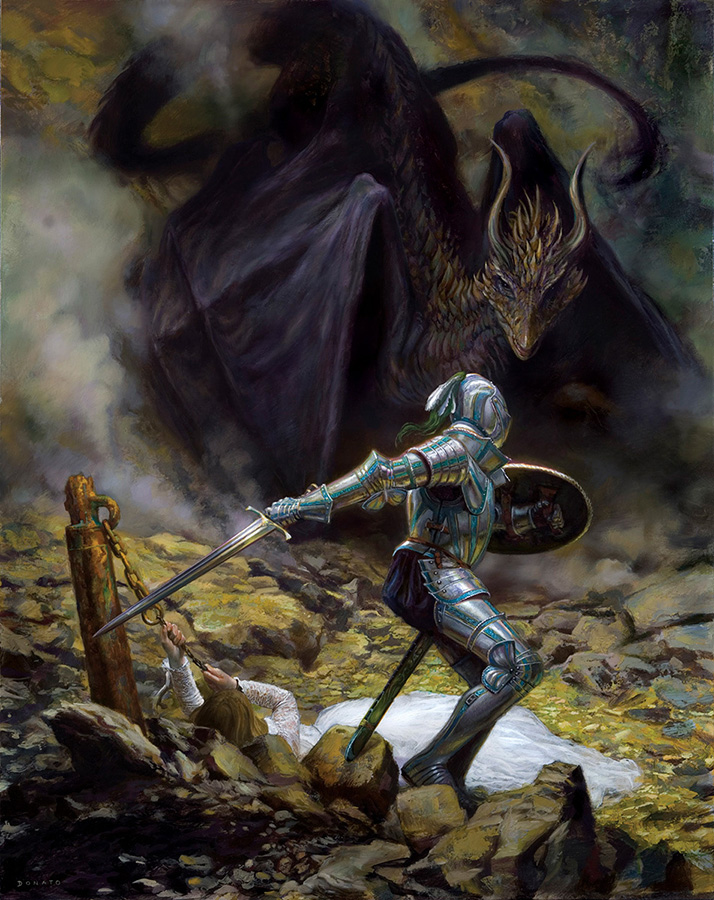
Enchanted: A History of Fantasy Illustration explores fantasy archetypes from the Middle Ages to today. The exhibition will present the immutable concepts of mythology, fairy tales, fables, good versus evil, and heroes and villains through paintings, etchings, drawings, and digital art created by artists from long ago to illustrators working today.
The exhibition Enchanted: A History of Fantasy Illustration is organized by the Norman Rockwell Museum in Stockbridge, MA, and will be on view here from June 12 through October 31, 2021.


